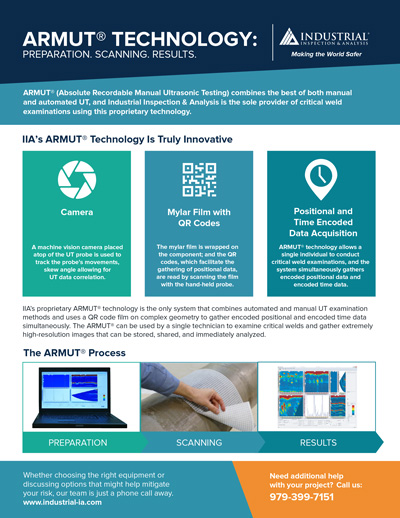Industrial Inspection & Analysis Nuclear Services’ Proprietary ARMUT®
Within the power industry, especially nuclear power, complying with the requirements of the American Society of Mechanical Engineering (ASME) Boiler and Pressure Vessel regulations is integral. Part of compliance is ensuring regular examinations of critical welds, which can reduce and sometimes even eliminate accidents. Using Ultrasonic (UT) examinations at power plants entails an extremely specific set of best practices to maintain the strictest codes of safety for everyone on site as well as the public at large.
When utilizing UT to conduct weld examinations, there are two options: manual/non-encoded and encoded. Non-Encoded, Manual UT, is relatively inexpensive but is more difficult to perform. The second option, Encoded, Automated UT, is viewed as an investment in technology, accuracy, and recording. Automated UT digitally saves all data gathered during the examination, which means the data can be reviewed and shared with others immediately after the examination, and can be stored for future reference.
ARMUT® (Absolute Recordable Manual Ultrasonic Testing) combines the best of both manual and Automated Phased Array UT (PAUT), and the Inspection Services Division of Industrial Inspection & Analysis (IIA) is the provider of critical weld examinations using this proprietary technology.
ARMUT® is a PAUT system that can gather and save encoded positioning data and encoded time data simultaneously. IIA’s additional proprietary application is a gridded QR Code Mylar film. This film is used to encode complex geometry, such as reducers or nozzles, and makes ARMUT® the most cutting-edge, advanced, and innovative PAUT examination system to date.
ARMUT® Ultrasonic Examination in Lieu of Radiography
At a power plant after configurations are changed, for example, after cutting out pipes, identifying corrosion or locating minimum wall violations, the rewelds take place. After that, it is typical to use radiography testing to reexamine the welds and ensure reliability. The subsequent problem with this examination method is the area must completely shut down for safety reasons, one being the risk of radiation exposure.
Instead of this expensive, unproductive, and hazardous option, choose to mobilize the professionals at IIA whose technicians will arrive with the world’s most innovative and cutting-edge ARMUT® system to provide PAUT in lieu of radiography. Outages can potentially last for days, weeks and even months, and implementing ARMUT® in lieu of radiography is the efficient and effective solution for sizable exclusion areas required for Radiographic Test (RT).
IIA’s Nuclear Services’ ARMUT® Technology is Truly Innovative
Camera
A machine vision camera has been placed atop the sensor. This allows sound to pass through, enter the material, hit its target, and then flaw characteristics can be measured.
Mylar Film with QR Codes
The mylar film is wrapped on the component, and the QR codes, which facilitate the gathering of positional data, are read by scanning the film with the hand-held probe.
Encoded Positional and Time Data
ARMUT® technology allows a single individual to conduct critical weld examinations, and the system simultaneously gathers encoded positional data and encoded time data as well.
IIA’s proprietary ARMUT® technology combines automated and manual UT examination methods and uses a QR code film on complex geometry to gather encoded positional and encoded time data simultaneously. The ARMUT® can be used by a single technician to examine critical welds and gather extremely high-resolution images that can be stored, shared, and immediately analyzed.
Benefits
- High POD (Probability of Detection) , especially for cracks and lack of fusion.
- Higher rate of detection for planar flaws
- Higher sizing accuracy rate
- Fewer rejects and repairs
- PAUT permits defect height measurement, which enables volumetric consideration of flaw severity (instead of only flaw type and length).
- No radiation emitted
- No additional licensing or personnel required
- Chemical or waste material produced
- Real-time analysis
- Digital setup and electronic reports
Reporting
IIA’s ARMUT® post-inspection reporting offers many benefits in contrast to conventional Radiography results. The information gathered during the ARMUT® inspection can be viewed electronically and in real-time. Conversely, with conventional radiography, the film needs to be developed, at which time it can be read and then analyzed. With ARMUT® technology, if an issue is identified that needs immediate attention, the customer is alerted in the field, can view the footage in real-time and can take immediate and appropriate action. Also, IIA’s report presentation is easy to read and understand. There is no technical jargon to sift through, and the findings are color-coded for interpretation ease. Finally, the reporting data can be quickly transferred and shared, when necessary.
While ultrasonic technology is always improving, for example, new machines, probes and techniques, the theory and foundation remain the same. This makes it easy for customers to continue implementing and understanding the advances in this technology.





